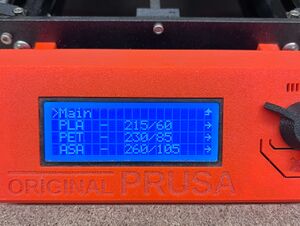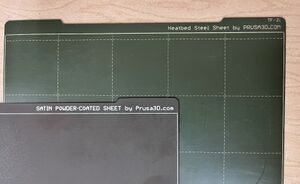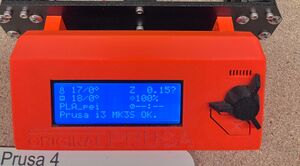MakeICT Prusa 3D Printers and Filament Types
There are many types of 3D printer filament available. It’s important to select the correct filament, slicer settings, and print surface for your printing job to achieve the best result and avoid causing damage to MakeICT’s 3D printers.
PLA filament is recommended unless you have a specific reason to use another type. The filament available for use on the filament shelf in FabLab is all PLA.
If you have questions about any of this information, please contact FabLab at fablab@makeict.org or reach out on the MakeICT forum at talk.makeict.org
Filament Type Guidelines for Use
Checking Filament Type
Before starting any print job, check the type of the filament you plan to use (this will usually be PLA). The type of filament should be clearly labeled on the spool. Please don’t use any filament that isn’t labeled or if you aren’t sure of the filament type.
In the slicer, always select the correct filament type for your print. Selecting one type of filament in the slicer and then using another could cause your print to fail and even damage the printer.
Loading/Unloading Filament
When loading filament in the Prusa 3D printers, always select the correct type of filament in the LCD screen when prompted. If one type of filament is loaded in the printer, and you are switching to another filament type, on the LCD screen always choose whichever of the two types has the higher nozzle temperature to ensure the higher temperature filament is either removed or loaded successfully.
For example, if the printer contains ABS (higher temperature filament) and you wish to switch to PLA (lower temperature filament), the nozzle will need to be hot enough to remove all the ABS during loading of the new filament.

Selecting Steel Plate
The removable, flexible steel plate is the printing surface that sits on the heatbed. Always check which plate is on the heatbed before sending your file to print.
- For PLA, use the Smooth PEI plate
- For PETG and ABS prints, use the Satin plate, which is slightly textured
For Prusa 5 (the MK4 printer) the printer will automatically detect the different print plates.
For Prusa 1, 2, 3, and 4, (the MK3S+ printers) each plate has a different preset in the Prusa LCD screen for the nozzle to print at the correct height. Check that the plate selected on the LCD screen matches the one on the heatbed.
The two options are:
- PLA_pei for the smooth PEI plate
- PET_ABS for the Satin plate
You can change the preset by clicking the black knob and scrolling to the sheet option. Click once to switch from one preset to the other.
We recommend you clean the plates with isopropyl alcohol before printing. When using the correct steel plate for your filament, no adhesives or release agents like hairspray or glue stick should be needed.
Extra plates are located on the shelf below the Prusa printers.


Enclosure
An enclosure is recommended when working with ABS filament. MakeICT currently doesn’t have an enclosure, but watch this space. In the meantime, when working with ABS select the “skirt” option in PrusaSlicer and set it as high as possible to keep the print warmer and prevent warping.
Multicolor Printing
When switching filament during a multicolor print job, make sure each filament is the same type.
Removing Finished Work
For ABS and PETG, allow the print to cool completely before removing from the print surface. Removing while warm can cause warping and damage of the part. Because of the higher temperatures, it may take several minutes for these prints to cool. If removing someone else’s work, check the filament type before removing to prevent damage.
Types of Filament
PLA
PLA works well for most casual prints and we recommend it for your print jobs at MakeICT unless you have a specific reason to use another type of filament. PLA is easy to work with and perfect for beginners.
Glow in the dark PLA or any filament with inclusions such as glitter may be too abrasive for use with a standard nozzle. Please contact FabLab for approval before using these types of filament.
Print surface: Smooth PEI plate is recommended. Satin plate can be used, but not recommended for small PLA parts as they don’t adhere well to textured plates.
PETG
More heat resistant than PLA, less prone to breaking, and waterproof, PETG is a better choice for mechanical parts for both indoor and outdoor use.
Print surface: Satin steel plate must be used. PETG adheres too strongly to the PEI plate and removal may damage the part and the plate.
ABS
More challenging to work with, ABS has a similar strength to PETG with better heat resistance. ABS is easier to paint and glue after printing, but is more prone to warping as it is sensitive to temperature fluctuations during printing. Using an enclosure to control temperature is recommended.
Print surface: Satin steel plate must be used. ABS adheres too strongly to the PEI plate and removal may damage the part and the plate.
Others
For all other types of filament, please contact FabLab before printing. Your filament may require a special setup.